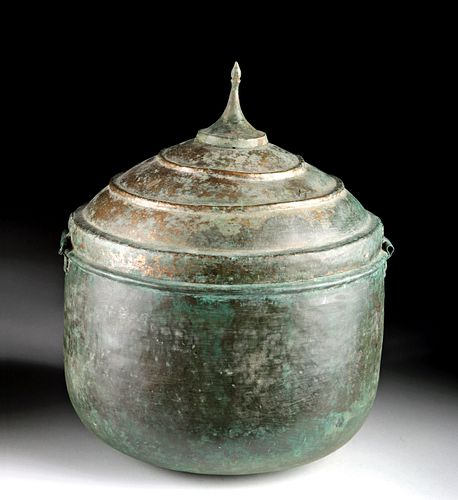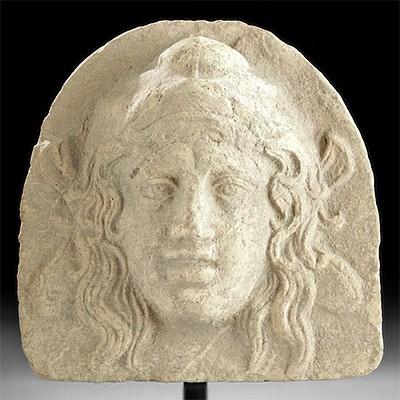Rare Greek Bronze Lidded Cauldron (Lebes / Urn)
Lot 31
About Seller
Artemis Fine Arts
686 S Taylor Ave, Ste 106
Louisville, CO 80027
United States
Selling antiquities, ancient and ethnographic art online since 1993, Artemis Gallery specializes in Classical Antiquities (Egyptian, Greek, Roman, Near Eastern), Asian, Pre-Columbian, African / Tribal / Oceanographic art. Our extensive inventory includes pottery, stone, metal, wood, glass and textil...Read more
Categories
Estimate:
$1,800 - $2,500
Absentee vs Live bid
Two ways to bid:
- Leave a max absentee bid and the platform will bid on your behalf up to your maximum bid during the live auction.
- Bid live during the auction and your bids will be submitted real-time to the auctioneer.
Bid Increments
| Price | Bid Increment |
|---|---|
| $0 | $25 |
| $300 | $50 |
| $1,000 | $100 |
| $2,000 | $250 |
| $5,000 | $500 |
| $10,000 | $1,000 |
| $20,000 | $2,500 |
| $50,000 | $5,000 |
| $100,000 | $10,000 |
| $200,000 | $20,000 |
About Auction
By Artemis Fine Arts
Feb 27, 2020
Set Reminder
2020-02-27 10:00:00
2020-02-27 10:00:00
America/New_York
Bidsquare
Bidsquare : VARIETY SALE | Antiquities & Ethnographic Art
https://www.bidsquare.com/auctions/artemis-gallery/variety-sale-antiquities-ethnographic-art-4920
Around the world & back in time - be amazed at the treasures you will find. Antiquities from Egypt, Greece, Italy and the Near East, Asian, Pre-Columbian, African / Tribal / Oceanic, Native American, Spanish Colonial, Russian Icons, Fine Art, much more! Artemis Fine Arts info@artemisfinearts.com
Around the world & back in time - be amazed at the treasures you will find. Antiquities from Egypt, Greece, Italy and the Near East, Asian, Pre-Columbian, African / Tribal / Oceanic, Native American, Spanish Colonial, Russian Icons, Fine Art, much more! Artemis Fine Arts info@artemisfinearts.com
- Lot Description
Greece, Classical Period, ca. late 6th to 5th century BCE. A beautiful, rare, lidded bronze cauldron, also known as a lebes or an urn. The body is wide and cylindrical, with deep, straight walls and a base that is slightly rounded at its edges, as if made to sit in sand or dirt rather than on a flat surface. The vessel's rim bulges outward, with two hinges attached to the rim and to the lid. Bronze rods, each with a looped handle on one end, slide through the hinges to hold the lid closed. The lid is rounded, with raised bands wrapped around its surface that give it a ziggurat-like appearance. It is capped by a sharply-pointed handle. Size: 8.75" W x 10.75" H (22.2 cm x 27.3 cm)
The lidded lebes was widely used throughout the classical world, including in Attic Greece and Etruria, both as a temple offering and as a cinerary urn for holding human remains wrapped in cloth. The size of this one suggests that it was probably used for the former. They were given as rewards to winning athletes (who might then use them as their own urns) and also were gifts given at banquets, again with the intention of ultimately being used in the grave. Most of our known examples come from elite tombs, and they were prized items in the ancient world.
See a similar vessel with a flat lid at the Louvre: https://www.louvre.fr/en/oeuvre-notices/lebes
Provenance: ex-Dr. Martin Peretz collection, Cambridge, Massachusetts, USA, acquired in the 1980s
All items legal to buy/sell under U.S. Statute covering cultural patrimony Code 2600, CHAPTER 14, and are guaranteed to be as described or your money back.
A Certificate of Authenticity will accompany all winning bids.
We ship worldwide and handle all shipping in-house for your convenience.
#145975Lid is sealed in place as the pins holding it closed cannot be moved. Handle on top of lid has been reattached. Beautiful mottled turquoise patina on surface. Slight bending to form on one side of lid. Overall in beautiful condition.Condition
- Shipping Info
-
All shipping is handled in-house for your convenience. Your invoice from Artemis Gallery will include shipping calculation instructions. If in doubt, please inquire BEFORE bidding for estimated shipping costs for individual items.
-
- Buyer's Premium



 EUR
EUR CAD
CAD AUD
AUD GBP
GBP MXN
MXN HKD
HKD CNY
CNY MYR
MYR SEK
SEK SGD
SGD CHF
CHF THB
THB
















